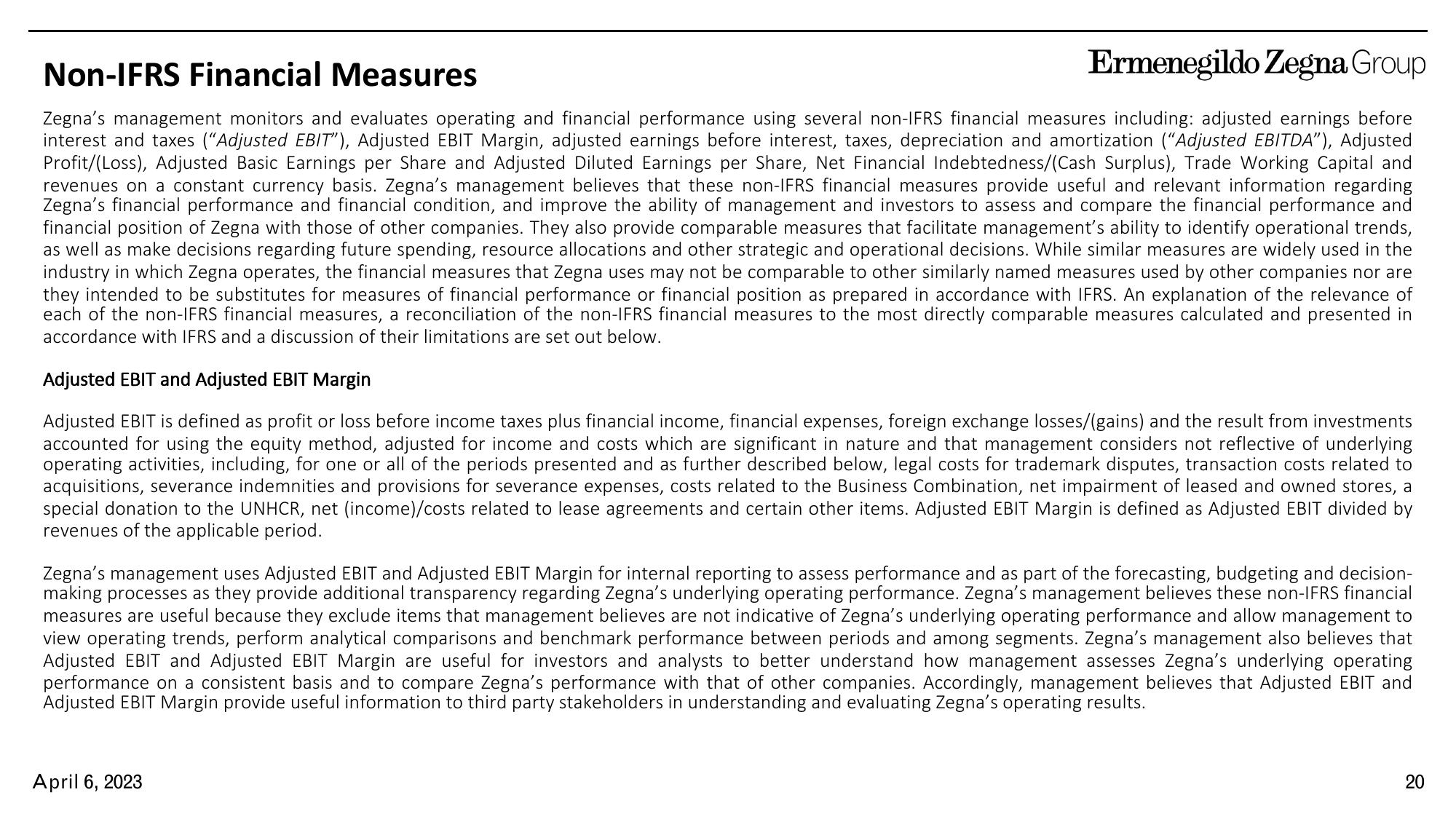Zegna Results Presentation Deck
Non-IFRS Financial Measures
Ermenegildo Zegna Group
Zegna's management monitors and evaluates operating and financial performance using several non-IFRS financial measures including: adjusted earnings before
interest and taxes ("Adjusted EBIT"), Adjusted EBIT Margin, adjusted earnings before interest, taxes, depreciation and amortization ("Adjusted EBITDA"), Adjusted
Profit/(Loss), Adjusted Basic Earnings per Share and Adjusted Diluted Earnings per Share, Net Financial Indebtedness/(Cash Surplus), Trade Working Capital and
revenues on a constant currency basis. Zegna's management believes that these non-IFRS financial measures provide useful and relevant information regarding
Zegna's financial performance and financial condition, and improve the ability of management and investors to assess and compare the financial performance and
financial position of Zegna with those of other companies. They also provide comparable measures that facilitate management's ability to identify operational trends,
as well as make decisions regarding future spending, resource allocations and other strategic and operational decisions. While similar measures are widely used in the
industry in which Zegna operates, the financial measures that Zegna uses may not be comparable to other similarly named measures used by other companies nor are
they intended to be substitutes for measures of financial performance or financial position as prepared in accordance with IFRS. An explanation of the relevance of
each of the non-IFRS financial measures, a reconciliation of the non-IFRS financial measures to the most directly comparable measures calculated and presented in
accordance with IFRS and a discussion of their limitations are set out below.
Adjusted EBIT and Adjusted EBIT Margin
Adjusted EBIT is defined as profit or loss before income taxes plus financial income, financial expenses, foreign exchange losses/(gains) and the result from investments
accounted for using the equity method, adjusted for income and costs which are significant in nature and that management considers not reflective of underlying
operating activities, including, for one or all of the periods presented and as further described below, legal costs for trademark disputes, transaction costs related to
acquisitions, severance indemnities and provisions for severance expenses, costs related to the Business Combination, net impairment of leased and owned stores, a
special donation to the UNHCR, net (income)/costs related to lease agreements and certain other items. Adjusted EBIT Margin is defined as Adjusted EBIT divided by
revenues of the applicable period.
Zegna's management uses Adjusted EBIT and Adjusted EBIT Margin for internal reporting to assess performance and as part of the forecasting, budgeting and decision-
making processes as they provide additional transparency regarding Zegna's underlying operating performance. Zegna's management believes these non-IFRS financial
measures are useful because they exclude items that management believes are not indicative of Zegna's underlying operating performance and allow management to
view operating trends, perform analytical comparisons and benchmark performance between periods and among segments. Zegna's management also believes that
Adjusted EBIT and Adjusted EBIT Margin are useful for investors and analysts to better understand how management assesses Zegna's underlying operating
performance on a consistent basis and to compare Zegna's performance with that of other companies. Accordingly, management believes that Adjusted EBIT and
Adjusted EBIT Margin provide useful information to third party stakeholders in understanding and evaluating Zegna's operating results.
April 6, 2023
20View entire presentation